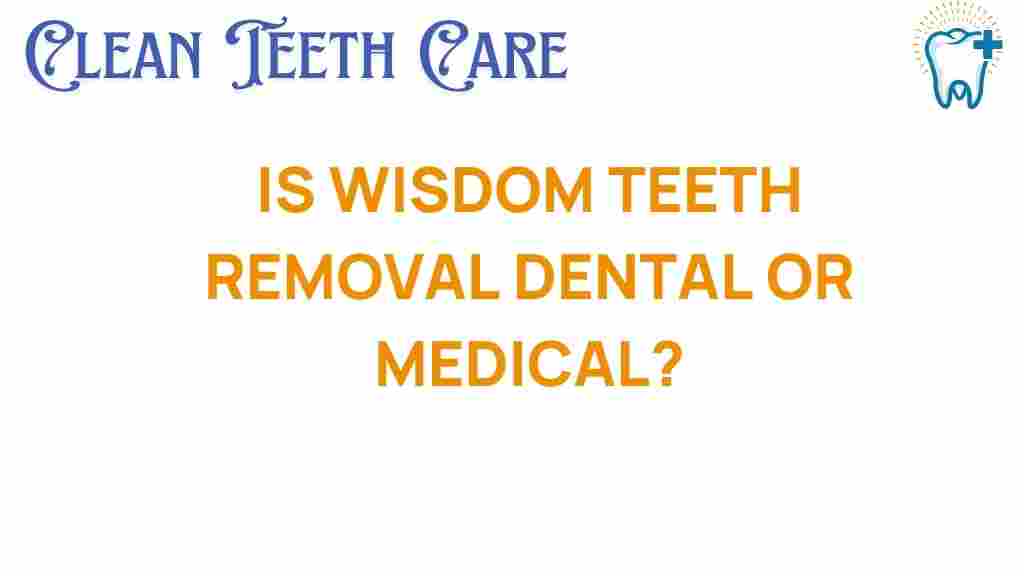Unveiling the Truth: Is Wisdom Teeth Removal a Dental or Medical Procedure?
Wisdom teeth, also known as third molars, typically emerge in late adolescence or early adulthood. For many, the arrival of these teeth can lead to a host of complications, necessitating their removal. This raises a fundamental question: is wisdom teeth removal classified as a dental procedure or a medical procedure? Understanding this distinction is crucial for patients considering the extraction of their wisdom teeth. In this article, we will explore the nature of wisdom teeth removal, the processes involved, the implications for oral health, and what patients can expect during recovery.
Understanding Wisdom Teeth
Wisdom teeth are the last set of molars to develop and usually appear between the ages of 17 and 25. While some individuals may have no issues with their wisdom teeth, others experience pain, overcrowding, or impaction. This can lead to various dental problems, including:
- Infection
- Cysts
- Damage to neighboring teeth
- Jaw pain
- Overcrowding of teeth
Given these potential complications, many dentists recommend the extraction of wisdom teeth as a preventive measure.
The Nature of Wisdom Teeth Removal: Dental Procedure or Medical Procedure?
The classification of wisdom teeth removal can vary depending on several factors, including the complexity of the extraction and the patient’s overall health. Here’s how we can differentiate between the two:
Dental Procedure
When wisdom teeth are removed in a routine manner, it is typically classified as a dental procedure. This involves:
- Assessment: The dentist evaluates the position of the wisdom teeth using X-rays.
- Extraction: The procedure is performed in the dentist’s office under local anesthesia.
- Post-Operative Care: The dentist provides instructions for recovery, focusing on oral health.
In most cases, a simple extraction can be completed with minimal complications, making it a standard dental procedure.
Medical Procedure
However, if the wisdom teeth are impacted (meaning they cannot fully emerge through the gums) or if the patient has underlying health issues, the extraction may be classified as a medical procedure. This can involve:
- General Anesthesia: The patient may require sedation or general anesthesia, especially if multiple teeth are being removed.
- Hospital Setting: More complex cases may necessitate performing the procedure in a surgical center or hospital.
- Comprehensive Monitoring: Medical professionals monitor the patient for any adverse reactions during the procedure.
In these cases, the procedure is more intensive and may involve greater risks, thus categorizing it as a medical procedure.
The Extraction Process
Whether classified as a dental or medical procedure, wisdom teeth extraction generally follows a similar process. Here’s a step-by-step guide:
Step 1: Consultation
The first step is a thorough consultation with your dentist or oral surgeon. This includes:
- Medical history review
- X-ray examination
- Discussion of potential risks and benefits
Step 2: Anesthesia Administration
Based on the complexity of the extraction, the dentist will determine the appropriate type of anesthesia:
- Local Anesthesia: Numbs the area around the tooth.
- IV Sedation: Induces a state of relaxation while keeping the patient awake.
- General Anesthesia: The patient is completely unconscious and will not remember the procedure.
Step 3: Extraction
Once the anesthesia takes effect, the dentist will:
- Make an incision in the gum tissue to expose the tooth.
- Remove any bone that may be blocking access to the tooth.
- Extract the wisdom tooth, sometimes in pieces.
- Clean the site of the extraction.
- Close the incision with stitches if necessary.
Step 4: Post-Operative Care
After the extraction, patients are given care instructions, which typically include:
- Taking prescribed pain medication
- Applying ice packs to reduce swelling
- Eating soft foods
- Avoiding strenuous activities for a few days
- Maintaining oral hygiene, but avoiding the extraction site
Recovery After Wisdom Teeth Removal
The recovery period varies from person to person but typically lasts a few days to a week. Here’s what patients can expect:
Immediate Aftercare
In the first 24 hours post-extraction, patients should focus on:
- Resting and minimizing physical activity
- Following all post-operative instructions provided by the dentist
- Monitoring for excessive bleeding or unusual pain
Signs of Complications
While many recover without issues, some may experience complications, such as:
- Dry Socket: A painful condition that occurs when the blood clot at the extraction site dislodges or dissolves.
- Infection: Signs include fever, chills, and increased swelling.
- Prolonged Bleeding: If bleeding does not subside after a few hours, contact your dentist.
Long-term Recovery
Most patients can resume normal activities within a week. However, full healing of the extraction sites may take several weeks. During this time, maintaining good oral health is essential.
Conclusion: The Final Verdict
In conclusion, whether wisdom teeth removal is classified as a dental procedure or a medical procedure largely depends on the complexity of the case and the patient’s health. Most extractions are straightforward and can be handled in a dental office, while more complicated cases may require a medical setting and specialized care. Regardless of the classification, the importance of patient care, effective recovery practices, and monitoring for complications cannot be overstated.
If you’re considering wisdom teeth removal, it’s vital to consult with your dentist to discuss the best approach for your specific situation. For more information on oral health and procedures, you can visit MouthHealthy.org.
Remember, maintaining good oral hygiene and regular dental check-ups can help prevent the need for wisdom teeth extraction in the first place. Your smile is worth the effort!
This article is in the category Treatments and created by CleanTeethCare Team
